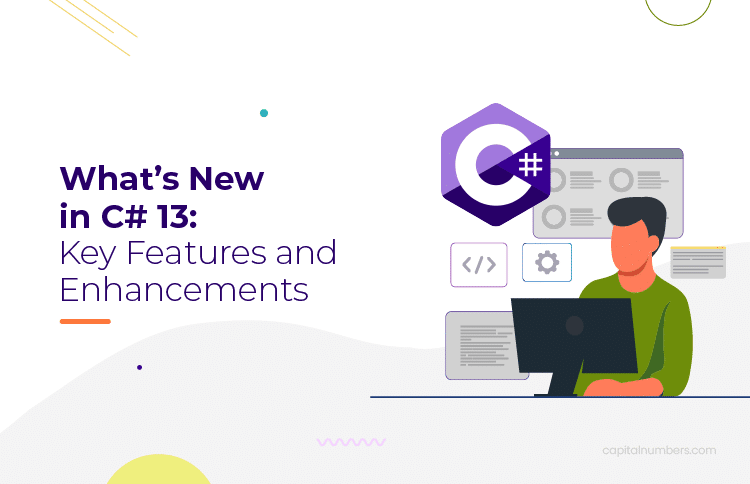What’s New in C# 13: Key Features and Enhancements
Table of Contents
Microsoft released C# 13 in September 2024, along with .NET 9, bringing a range of new features designed to enhance developer productivity. These updates focus on improving code efficiency, flexibility, and performance. In modern programming, keeping up with these advancements is crucial as they help streamline development workflows, tackle complex technical challenges, and ensure you can build scalable, high-quality applications. With each release, developers gain powerful tools to stay competitive and deliver better software faster.
In this blog, we explore the key features introduced in C# 13. If you’re curious about what’s new, keep reading to find out how these updates can streamline your development process.
1. Params Collections Expansion
In C# 13, the “params” modifier, which allows passing a variable number of arguments to a method, now supports collections beyond arrays. Previously, “params” only worked with arrays, but now you can use it with collections like “List, Span”, and “IEnumerable”.
Example:
Here’s how you can use params with a List:
public void AddItems(params List items)
{
foreach (var item in items)
{
Console.WriteLine(item);
}
}
AddItems(new List { 1, 2, 3 }, new List { 4, 5, 6 });
This flexibility allows C# developers to handle a broader range of collection types, improving code readability and ease of use in methods that work with multiple elements.
2. New Lock Type for Thread Synchronization
In C# 13, a new type for thread synchronization, “System.Threading.Lock”, is introduced. This lock type simplifies and enhances thread synchronization by providing better control over shared resources.
Key Benefits:
- Scoped Locking: The “Lock.EnterScope()” method allows you to enter a critical section and automatically releases the lock when the scope ends, making the code cleaner and less error-prone.
Example:
Lock myLock = new Lock();
using (myLock.EnterScope())
{
// Critical section - only one thread can execute this at a time.
Console.WriteLine("Thread-safe code here.");
}
In this example, the lock ensures that the code inside the “using” block is thread-safe. The lock is released automatically when the block ends, making synchronization easier to manage. This feature improves the reliability and readability of your code when working with multithreaded applications.
3. Escape Sequence Enhancements
C# 13 introduces a new escape sequence, “\e”, which represents the ASCII escape character (Unicode “U+001B”). Previously, C# developers had to use “\u001B” or “\x1B” to reference this character. The new \e escape sequence simplifies the process by providing a shorthand notation for the escape character, making the code cleaner and easier to read.
Example:
string escapeSequenceExample = "\e[31mThis text is red\e[0m";
Console.WriteLine(escapeSequenceExample);
In this example, the \e escape sequence can be used for terminal color formatting or other purposes where the escape character is needed. This feature is particularly useful for C# developers working with console applications or systems that rely on ASCII escape sequences for formatting or control commands.
You May Also Read: Building Machine Learning Models with C# (With Code Samples)
4. Overload Resolution Priority
C# 13 introduces the “OverloadResolutionPriorityAttribute”, which allows C# developers to designate one method overload as better than others. This feature is helpful when you want to add a new, more efficient overload without breaking existing code. By assigning a priority to an overload, you guide the compiler to select the preferred method during compilation.
Example:
public void DoSomething(int a) => Console.WriteLine("Int overload");
[OverloadResolutionPriority(1)]
public void DoSomething(double a) => Console.WriteLine("Double overload");
In this example, the compiler will prefer the double overload due to its higher priority. This attribute makes it easier to manage multiple overloads while maintaining backward compatibility in libraries and APIs.
5. Implicit Indexer Access in Object Initializers
In C# 13, a new feature allows developers to use implicit index access in object initializers. This simplifies array initialization by letting you use the ^ operator (from the end) directly within an object initializer. It removes the need for writing out array indices explicitly.
Example:
var countdown = new TimerRemaining()
{
buffer =
{
[^1] = 0,
[^2] = 1,
[^3] = 2,
[^4] = 3,
[^5] = 4
}
};
This creates a countdown array where the last item ([^1]) is initialized to 0, and the second-to-last ([^2]) is initialized to 1, and so on. This makes it easier to initialize arrays with elements accessed from the end.
6. Ref Struct Types in Generics and Iterators
C# 13 introduces more flexibility for using “ref struct” types, enabling them in generics and iterators. A “ref struct” is a structure that cannot be allocated on the heap, ensuring better memory safety in high-performance scenarios.
Example: Using“ref struct”in Generics
public class Processor where T : allows ref struct
{
public void Process(T data)
{
// process data of type ref struct
}
}
This allows types like “Span” to be used with generics, expanding the flexibility of “ref” types in performance-critical applications. It ensures safety rules while using these types, like no heap allocations.
Looking for expert C# developers to bring your business goals to life? Our team specializes in delivering top-tier solutions using the latest features of C# 13, ensuring enhanced performance, scalability, and security for your projects.
Conclusion
C# 13 introduces several key improvements that enhance developer productivity and code efficiency. With updates like “params” collections, new lock types for better thread synchronization, and the “OverloadResolutionPriority” attribute, developers now have more control and flexibility. Additionally, features such as implicit indexer access and improved support for “ref struct” types in generics streamline tasks and improve memory safety. These updates make custom software development easier by enabling developers to build cleaner, more efficient, and scalable solutions tailored to business needs.















